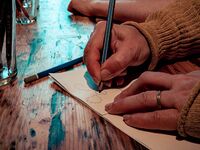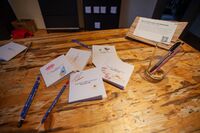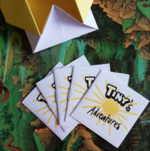User:Clara/Project: Difference between revisions
| Line 119: | Line 119: | ||
Last year I created Tiny's adventure which was one of the first step towards this type of project. Tiny's adventures are short one line stories about daily life. I made two editions, which I called "The Happy Edition" and "The Anxiety Edition". Each edition contained 5 zine with a one line story and illustration, they were put together in an origami folded box. All of this was also very small in format and fit in the palm of a hand. This work was the beginning of me experimenting with short and quick ways to tell stories. It was also about the idea that very little can say a lot and that there can be hidden meanings behind words and illustrations. | Last year I created Tiny's adventure which was one of the first step towards this type of project. Tiny's adventures are short one line stories about daily life. I made two editions, which I called "The Happy Edition" and "The Anxiety Edition". Each edition contained 5 zine with a one line story and illustration, they were put together in an origami folded box. All of this was also very small in format and fit in the palm of a hand. This work was the beginning of me experimenting with short and quick ways to tell stories. It was also about the idea that very little can say a lot and that there can be hidden meanings behind words and illustrations. | ||
==Relation to larger context== | ===Relation to larger context=== | ||
I believe this method can help get people out of their daily life for a short amount of time and give them a new perspective. We believe we think outside the box when we are asked to but I think that that notion in itself is restrictive and can block imagination. I think thinking outside the box can be restrictive and not allow for more creative ways of thinking. I believe that the method I'm developing could facilitate a new way to trigger creativity. It's a new step towards addressing problems and solving them. | I believe this method can help get people out of their daily life for a short amount of time and give them a new perspective. We believe we think outside the box when we are asked to but I think that that notion in itself is restrictive and can block imagination. I think thinking outside the box can be restrictive and not allow for more creative ways of thinking. I believe that the method I'm developing could facilitate a new way to trigger creativity. It's a new step towards addressing problems and solving them. | ||
Revision as of 14:13, 2 December 2021
Publication generator
On the topic of fables, short stories, one liners. Generating randomised morals that teach us something.
Creating structure
Workshop at leeszaal
Coding generative stories
intro = ("sunny day", "day unlike an other", "cold evening", "gloomy day")
character = ("cat", "pen", "dog", "tree")
characters = ("cat", "pen", "dog", "tree")
location = ("parking lot", "sauna", "school")
object = ("flag", "ladder", "banana", "lunchbox")
action = ("protest", "study", "get therapy")
moral = ("make a difference", "learn from each other", "feel happier")
end = ("ended", "continued", "started")
import random
i = random.choice(intro)
c = random.choice(character)
h = random.choice(characters)
l = random.choice(location)
o = random.choice(object)
a = random.choice(action)
m = random.choice(moral)
e = random.choice(end)
for x in range (1):
print(f"On a {i}")
print(f"Appeared a {c} and a {h}")
print(f"They found themselves in a {l}")
print(f"The {c} had brought a {o}")
print(f"They were there to {a}")
print(f"Hoping to {m}")
print(f"And so the day {e}")
Outputs: On a cold evening Appeared a dog and a pen They found themselves in a school The dog had brought a lunchbox They were there to get therapy Hoping to feel happier And so the day started On a gloomy day Appeared a dog and a tree They found themselves in a parking lot The dog had brought a flag They were there to protest Hoping to make a difference And so the day continued
Workshop at Mediamatic
Project proposal
LIBRARY OF MORALS
Your stories
Your solutions
Your imagination
The stories created by generative story workshops
What are you making?
I am developing generative short story workshops as methods to "solve" problems. "Solve" in quotation because the aim of the workshops is not to realistically solve problems but rather to have a creative take on the problems. The idea is also to solve them by triggered children's imagination which gives shape to the unimginable. The method aims to trigger quick responses trying to escape the adult way of overthinking and analyzing. And so this can let through the child imagination that is always in you. This method aims to be therapeutic. With a set topic and a set structure the participants are taken on a story making journey to solve and express the topic given to them. The workshop opens conversations as the participants are invited to discuss the story they created to solve their given problem. It aims to create a playful way to tackle serious topics. It also aims to opens minds and create a new perspective of problem solving.
My creative story-making method is adaptable to different audiences and in turn can help express and deal with relevant topics for these audiences. The development of this workshop is strongly inspired by the structure and methods used in children’s stories and fables to teach morals and ways of behaving, as well as social media platforms that try to quickly convey information concisely and in short amounts of time. It gives short sentences in combination with illustration space to speak and convey more than what is simply written. It thus also accommodates to visual thinkers and gives space for again more imagination. The method really aims to take steps in surprising the participant with their own triggered imagination. It is not the aim that the participant fully knows what they are writing in terms of structure and also that they will be illustrating. Of course some can assume but still the quick thinking moment where the imagination is triggered will not be lost.
The workshops use a printed and set story structure with elements to be filled in by the participants. For each workshop the fill in story is changed to adapt to the topic of the workshop. The workshop given to younger participants will change and adapt to the age. After the story is filled in the participants are asked to illustrate their stories. After each session the stories are scanned to keep a digital copy of the stories and the participants will be given their books back. The contents gathered will be used as material for a publication of this graduation work. Also important to mention that if I am to use the content I gathered it will be done after I have asked consent from the participants.
Planning
November
~ Organizing and doing workshop with School voor Jong Talent at KABK
~ Adapt a workshop or an overview of work for November 29th Xpub session
~ Get in contact with Page Not Found about participating in Page of Possibilities
~ Brainstorm about the form that the work could take for the graduation (and then prototype)
~ Preparation for december workshop with office workers
~ Come up with a transportable method to scan all the produced book and give back to participants
December
~ Workshop with office workers
~ Work on form that the work will take for graduation (digitalizing)
~ Possibly contact more places for workshops to take place
~ Collaboration with Yara with kids in Palestine
January~February
~ More workshops
~ Work on form that the work will take for graduation (digitalizing)
~ Brainstorm on way to bring all the content back into a publication
March~May
~ Print publication created
~ Finalise graduation format and plan/gather what would be physically needed
Why do you want to make it?
Thinking outside the normal is something fascinating. To think and create with the imagination of a young child. To have no boundaries. I think that very little can say a lot and that's what this project started from. The simplicity of children's stories and the crazy idea that come from a child's imagination put together as a method to solve problems. I want to allow for a different way to express issues and I want it to be playful. I want to open conversations and to allow for the participants to get in touch with their creativity and their locked away "childish" way of thinking. I want to use what's already there and give it a twist and I want to allow people to think outside their box through this method I'm developing. I just think we're too often restraining ourselves in the way we express ourselves and I want to let people feel like they can set a part of them free in this generative story workshop.
Who can help you and how?
Page of Possibilities organizer ~ knowledge and experience doing workshops with kids (also with multiple languages)
School voor Jong Talent educators ~ know how to structure art lessons and workshops for kids
Leslie ~ putting me in contact with places to organize workshops
Michael and Manetta ~ with brainstorming and technical aspects of digitalization
Relation to previous practice
Last year I created Tiny's adventure which was one of the first step towards this type of project. Tiny's adventures are short one line stories about daily life. I made two editions, which I called "The Happy Edition" and "The Anxiety Edition". Each edition contained 5 zine with a one line story and illustration, they were put together in an origami folded box. All of this was also very small in format and fit in the palm of a hand. This work was the beginning of me experimenting with short and quick ways to tell stories. It was also about the idea that very little can say a lot and that there can be hidden meanings behind words and illustrations.
Relation to larger context
I believe this method can help get people out of their daily life for a short amount of time and give them a new perspective. We believe we think outside the box when we are asked to but I think that that notion in itself is restrictive and can block imagination. I think thinking outside the box can be restrictive and not allow for more creative ways of thinking. I believe that the method I'm developing could facilitate a new way to trigger creativity. It's a new step towards addressing problems and solving them.
Through my thesis research I have also come to find very relevant workshops and methods that have been created. One which is the Serious Play and more specifically Serious Pay Lego which were done with adults in their office and work environment and they had to build with lego their workspace. The therapeutic and playful aspect of this workshop strongly relates to what I'm doing. Another method which is very relevant is also the psychology behind children's drawings and drawing as a therapeutic method. On top of this I also learned about Surrealist Automatism which "is a method of art-making in which the artist suppresses conscious control over the making process, allowing the unconscious mind to have great sway."(Surrealist automatism - Wikipedia, 2021) This also obviously strongly resonates in my work and the method I've developed.
Resources
1.Besson, A., n.d. De l’aristocratie aux cours d’école, une brève histoire du conte | Fantasy - BnF. [online] Fantasy.bnf.fr. Available at: <https://fantasy.bnf.fr/fr/comprendre/de-laristocratie-aux-cours-decole-une-breve-histoire-du-conte/> [Accessed 21 November 2021].
(Besson, n.d.)
2. Blair, S., Rillo, M. and Dröge, J., 2020. Serious Work How to facilitate meetings and workshops using the LEGO® Serious Play® method. 3rd ed.
(Blair, Rillo and Dröge, 2020)
3. Brinkman, G., 2020. TOTO TO TOTORO Can talking animals save the world?. Masters. The Royal Academy of Arts The Hague.
(Brinkman, 2020)
4. Di Leo, J., 2013. Interpreting Children's Drawings. Routledge.
(Di Leo, 2013)
5.Fr.wikipedia.org. 2021. Fable — Wikipédia. [online] Available at: <https://fr.wikipedia.org/wiki/Fable> [Accessed 17 November 2021].
(Fable — Wikipédia, 2021)
6. Farokhi, M. and Hashemi, M., 2011. The Analysis of Children's Drawings: Social, Emotional, Physical, and Psychological aspects. Procedia - Social and Behavioral Sciences, 30, pp.2219-2224.
(Farokhi and Hashemi, 2011)
7. Inovation Hub, 2015. Kids say the smartest things. [podcast] Available at: <https://soundcloud.com/innovationhub/kids-say-the-smartest-things> [Accessed 12 November 2021].
(Inovation Hub, 2015)
8. Lucas, C., Bridgers, S., Griffiths, T. and Gopnik, A., 2014. When children are better (or at least more open-minded) learners than adults: Developmental differences in learning the forms of causal relationships. Cognition, 131(2), pp.284-299.
(Lucas, Bridgers, Griffiths and Gopnik, 2014)
9. Quaglia, R., 2015. THE USE OF DRAWING IN PSYCHOTHERAPY. International Journal of Developmental and Educational Psychology, 1(1), pp.465-472.
(Quaglia, 2015)
10. En.wikipedia.org. 2021. Surrealist automatism - Wikipedia. [Accessed 17 November 2021].
(Surrealist automatism - Wikipedia, 2021)
11. Wheeler, S., Passmore, J. and Gold, R., 2020. All to play for: LEGO® SERIOUS PLAY® and its impact on team cohesion, collaboration and psychological safety in organisational settings using a coaching approach. Journal of Work-Applied Management, 12(2), pp.141-157.
(Wheeler, Passmore and Gold, 2020)




